

Jericoacoara: Princess of the Sea
By: Carolina Pinheiro
Photos: Tom Alves
Many years ago, Delmira Silvestre das Chagas Silva set up a small stand on the beach, hoping to earn a living from tourism. She is a wonderful storyteller, so she is usually surrounded by an attentive group listening to her entertaining tales. She spends hours telling visitors about the culture of Nova Tatajuba, a fishing village near Jericoacoara, a tropical paradise in the far north of the state of Ceará. Although this fishing village used to be quite isolated, its exquisite landscapes brought it to the world’s attention in the 1980s, and it became the state’s main attraction.
Jeri, as it is known to both local inhabitants and visitors, is one of the most popular destinations in northeastern Brazil due to the diversity of its landscapes: beaches, lagoons, dunes, cliffs, and year-round sun attract tourists by the thousands from Brazil and abroad. This oasis sits among the enormous dunes of Jericoacoara National Park, which spreads over some 15,500 acres and is nearly inaccessible to conventional vehicles. It is famous for its lush natural beauty, its hospitable people, and the Rota das Emoções, which runs through the states of Piauí and Maranhão. Lovers of the outdoor life will find so many activities on offer that they should plan to spend at least a week here.
The town has retained its charming rustic side, while providing excellent lodging and varied dining with an emphasis on seafood. The sandy lanes are lined with lovely houses, and there is a shopping district with inviting restaurants, cozy bars, ice-cream shops, and cafés. Tourist guide Flavio Morales remarks, “The old name of the town was Vila Serrote. We used to make a living from fishing, but it is rare to see a fisherman around here now that tourism has become the town’s main source of income. When I started out, we used to guide the tourists on foot. I would load the luggage on a mule and we would walk to Jijoca. Very few people came.”

Unparalleled Beauty
The park covers 125 miles between the beaches of Preá and Guriú. Jeri’s seafront stretches a mile and a quarter long and it is divided by a sandy point: to the east is Praia da Vila and to the right Praia da Malhada. Visitors can take the beach path if the tide is out, or use the Morro do Serrote road at high tide. The best thing to do is arrive by one path and return by the other, since the view is gorgeous from both roads. Along the way, visitors will pass small, deserted beaches, surrounded by crags, orange sand cliffs, and crescents of white sand washed by the sea.
The mile and a quarter walk to Pedra Furada, the area’s tourism symbol, is well worth it, because there is no better place to admire the region’s beauty. This natural formation consists of a lovely rock arch over the beach. Curiously, during the winter solstice, the setting sun seems to nestle perfectly into the arch, creating an incomparably beautiful sight. The perfect place to watch this daily display is a 100-foot-high dune next to Praia das Canoas. When the moon is full, the sun sets on one side and the moon rises on the other. Very near here, a fantastic lookout point gives visitors a panoramic 360 degree view of the city and Jericoacoara National Park.


Outdoors
The area’s beaches and crystalline lagoons are very popular, especially from July to September, when many foreign tourists vacation here. The winds create excellent conditions for sports like sailing, surfing, and kite surfing in the Azul and Paraíso lagoons in Jijoca, which are also ideal for swimming, kayaking, and diving. This lovely spot can be reached in the 4×4 vehicles that depart from Villa de Jericoacoara. Another fun option is to rent a beach buggy for the drive to the Azul lagoon.
Lunch at Jijoca Lake, also known as Lagoa do Paraiso, is a traditional stop along the way. The return trip passes through the huge dunes of the National Park. There is another road that goes as far as Lagoa da Nova Tatajuba, with views of the Mangue Seco beach, the mangroves of the Guriú River, and the ruins of the old town of Tatajuba buried in the dunes.
Isla del Amor (Love Island) in Camocim is a fishing spot with a rustic atmosphere. Fisherman Edmar tells us that the name came from a Romeo and Juliet-style romance more than one hundred years ago. “According to legend, two rival families refused to let their children see each other. The two young people fled to this island, where they spent forty happy, peaceful years.” The name pays tribute to the story. Even though boat traffic is more intense now, the bucolic, picture-perfect setting continues to draw loving couples.


There and Back
The state of Ceará, measuring some 56,000 square miles, is often used as a gateway to the Rota das Emoções. The road leads from the modern city of Fortaleza, with its spirited night and cultural life, to Jericoacoara. The beach is a district of Jijoca, a city of bustling businesses, limited tourism facilities, a handful of inns, and an economy based on agriculture (mainly cashew apples and chestnuts). The town has 19,000 residents, fewer than 2,000 of whom live near Jericoacoara beach.
Palm trees, white sand, and a sea shaded in several tones of blue make the beach the coast’s principal attraction and a draw for adventurers. Ecotourism is the most frequent type of travel in Jeri, and the local inhabitants cordially welcome visitors. In fact, the visitors who come are also very interested in the local culture; there is a good reason it is said that people fall in love with this place after only one visit. “Anyone who has ever been to Jericoacoara will never forget it,” says Delmira, the Tatajuba storyteller. “It is a place for love.” And a place to which visitors want to return as soon as possible.


Services
Many tourism operators serve Jericoacoara National Park, one of the best being Natur Turismo. The cosmopolitan air of Jeri and its reputation as a party town have led to expanded hotel options. There are many possibilities for lodging and a great variety of dining choices, ranging from seafood dishes from the coast (fish, shrimp, lobster, and crab) to inland fare like carne de sol (salted, sun-cured meat), baião-de-dois (rice and beans), macaxeira (cassava), and cuscuz de milho (cornmeal couscous).



